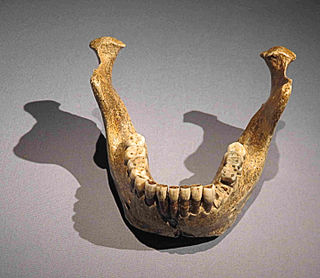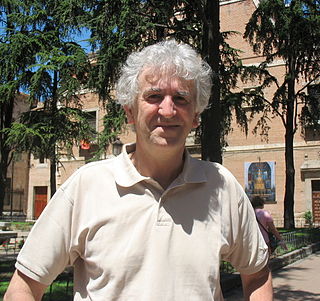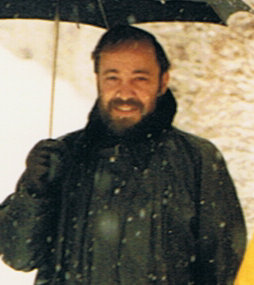
University of Rovira i Virgili is located in the Catalan cities of Tarragona and Reus, Spain. Its name is in honor of Antoni Rovira i Virgili.

Homo heidelbergensis is an extinct species or subspecies of archaic human which existed during the Middle Pleistocene. It was subsumed as a subspecies of H. erectus in 1950 as H. e. heidelbergensis, but towards the end of the century, it was more widely classified as its own species. It is debated whether or not to constrain H. heidelbergensis to only Europe or to also include African and Asian specimens, and this is further confounded by the type specimen being a jawbone, because jawbones feature few diagnostic traits and are generally missing among Middle Pleistocene specimens. Thus, it is debated if some of these specimens could be split off into their own species or a subspecies of H. erectus. Because the classification is so disputed, the Middle Pleistocene is often called the "muddle in the middle".

Homo antecessor is an extinct species of archaic human recorded in the Spanish Sierra de Atapuerca, a productive archaeological site, from 1.2 to 0.8 million years ago during the Early Pleistocene. Populations of this species may have been present elsewhere in Western Europe, and were among the first to colonise that region of the world, hence the name. The first fossils were found in the Gran Dolina cave in 1994, and the species was formally described in 1997 as the last common ancestor of modern humans and Neanderthals, supplanting the more conventional H. heidelbergensis in this position. H. antecessor has since been reinterpreted as an offshoot from the modern human line, although probably one branching off just before the modern human/Neanderthal split.
The Atapuerca Mountains is a karstic hill formation near the village of Atapuerca in the province of Burgos, northern Spain.

A pyrena or pyrene is the fruitstone within a drupe or drupelet produced by the ossification of the endocarp or lining of the fruit. It consists of a hard endocarp tissue surrounding one or more seeds. The hardened endocarp which constitutes the pyrene provides a protective physical barrier around the seed, shielding it from pathogens and herbivory.

The timeline of human evolution outlines the major events in the evolutionary lineage of the modern human species, Homo sapiens, throughout the history of life, beginning some 4 billion years ago down to recent evolution within H. sapiens during and since the Last Glacial Period.

Juan Luis Arsuaga Ferreras is a Spanish paleoanthropologist and author known for his work in the Atapuerca Archaeological Site.
Antoni Rovira i Virgili was a Spanish politician and journalist who was president of Catalonia's Parliament in exile after the Spanish Civil War. His term of office lasted from 1940 to 1949.

Ursus deningeri is an extinct species of bear, endemic to Eurasia during the Pleistocene for approximately 1.7 million years, from 1.8 to 0.1 million years ago.

Emiliano Aguirre Enríquez was a Spanish paleontologist, known for his works at archaeological site of Atapuerca, whose excavations he directed from 1978 until his retirement in 1990. He received the Prince of Asturias Award in 1997.
Grotte du Vallonnet is an archaeological site located near Roquebrune-Cap-Martin, between Monaco and Menton, in France, that was first discovered in 1958. Stone tools found at the site have been dated to between 1 and 1.05 million years old, making it one of the earliest sites of human settlement known in Europe.

The Museum of Human Evolution is situated on the south bank of the river Arlanzón, in the Spanish city of Burgos. It is located roughly 16 kilometers west of the Sierra de Atapuerca, the location of some of the most important human fossil finds in the world. In addition, the Archaeological site of Atapuerca, which was declared a World Heritage Site in 2000, has yielded some of the exhibits at the museum.

Several expansions of populations of archaic humans out of Africa and throughout Eurasia took place in the course of the Lower Paleolithic, and into the beginning Middle Paleolithic, between about 2.1 million and 0.2 million years ago (Ma). These expansions are collectively known as Out of Africa I, in contrast to the expansion of Homo sapiens (anatomically modern humans) into Eurasia, which may have begun shortly after 0.2 million years ago.

Jordi Agustí is a Spanish paleontologist at the Instituto de Paleoecología Humana y Evolución Social at the Universitat Rovira i Virgili. His research is mainly focused on the evolution of mammal fossils in relation to changing climates in the last 10 million years. He has led investigations in Europe and in North Africa, and he was part of the team that discovered some of the oldest Eurasian hominids in Dmanisi, Georgia.
Ursus dolinensis is an extinct mammalian carnivore species of the Ursidae family. Its fossilized remains were unearthed from the lowest layers of the stratigraphic sequence at the archaeological and paleontological site of Gran Dolina, that is a part of the Atapuerca Mountains complex in the Burgos province, northern Spain. The species was described by Nuria Garcia and Juan Luis Arsuaga in a 2001 publication. Skeletal fossils, mainly cranial fragments were recovered from the sediment units TD 3 and in particular TD 4. Presence in these layers suggests a chronology in between 900,000 and 780,000 years ago, which falls into the Calabrian stage of the early Pleistocene.

The archaeological site of Atapuerca is located in the province of Burgos in the north of Spain and is notable for its evidence of early human occupation. Bone fragments from around 800,000 years ago, found in its Gran Dolina cavern, provide the oldest known evidence of hominid settlement in Western Europe and of hominid cannibalism anywhere in the world.

Cova Negra is an archaeological site near the town of Xàtiva in the Province of Valencia, Spain, with remains that show sporadic and short-term occupation by Neanderthals in the Mousterian period.

Paleolithic in the Iberian peninsula is the longest period of its prehistory, starting c. 1.3 million of years (Ma) ago and ending almost at the same time as Pleistocene, first epoch of Quaternary, c. 11.500 years or 11.5 ka ago. It was a period characterized by climate oscillations between ice ages and small interglacials, producing heavy changes in Iberia's orography. Cultural change within the period is usually described in terms of lithic industry evolution, as described by Grahame Clark.

The Orce Man, Orce Donkey, or Venta Micena fossil is a fossil cranium fragment that was historically considered an infantile early European member of Homo, but recent descriptions suggest that it is a member of the species Equus altidens.















